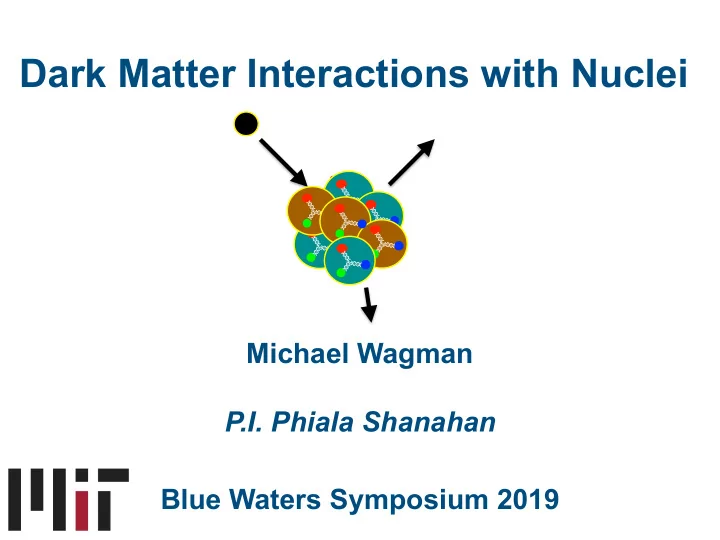

Dark Matter Interactions with Nuclei Michael Wagman P.I. Phiala Shanahan Blue Waters Symposium 2019
What we know e − e − e − Gravity Electromagnetism e − Weak Force Strong Force ν e � 2
What we know � 3
<latexit sha1_base64="swmNRK2o8K1Hz6meupivKrMWKyI=">A B7nicbVBNS8NAFHypX7V+VT16WSyCp5Ko AcPBS8ePFSwt CGstls2qWbTdh9EUroj/DiQRGv/h5v/hu3bQ7aOrAwzMxj35sglcKg6347pZXVtfWN8mZla3tnd6+6f/Bok wz3mKJTHQnoIZLoXgLBUreSTWncSB5OxjdTP32E9dGJOoBxyn3YzpQIhKMopXavTsbDWm/WnPr7gxkmXgFqUGBZr/61QsTlsVcIZPUmK7npujnVKNgk 8qvczwlLIRHfCupYrG3Pj5bN0JObFKSKJE26eQzNTfEzmNjRnHgU3GFIdm0ZuK/3ndDKMrPxcqzZArNv8oyiTBhExvJ6HQnKEcW0KZFnZXwoZU 4a2oYotwVs8eZk8ntW987p7f1FrXBd1lOEIjuEUPLiEBtxCE1rAYATP8ApvTuq8O /OxzxacoqZQ/gD5/MHCoGPWQ= </latexit> What we don’t know Astrophysical and cosmological observations show that most of the universe is not ordinary Standard Model matter Best-fit CDM Λ Ordinary matter only CMB power spectrum Black Points - WMAP data https://lambda.gsfc.nasa.gov/education/cmb_plotter/ � 4
What we don’t know � 5
Dark matter direct detection Experiments look for nuclei recoiling from scattering with something invisible Heavy nuclei are often used to maximize sensitivity Standard Model theory needed to relate nucleus - dark matter interactions with proton (or quark) - dark matter interactions Theory assumptions LUX � 6 � 6 Akerib et al (LUX), PRL 118 (2017)
Naive nuclei Nuclei = naive shell model + QCD effects Axial / tensor currents couple to nuclear spin ( ( spin spin spin spin = = Naive shell model spin Scalar currents couple to total quark number of nucleus, — Dominate spin-independent dark matter scattering = + + Naive shell � 7 model
zOZneUHdJ/6QmEr8xHuMEusYvKchuvfdb7h0x+WEaV r hVdwD6l3hDUiFD1FrlVz+MeRqBQi6ZMQ3PTbCZMY2CS8hLfmogYbzLbqBhqWIRmGY2uDqna7YT0nas7VNIB92fjoxFxvSiwE72/2tGNGPXdSDMfxv6k/8ZGim2d5uZUEmKoPjX9nYqKca0nysNhQaOsmcJ41rYAyjvM 042vRLNhnvdw5/yeVm1duqu fblcOjYUZTZIWsknXikR1ySE5IjdQJ /fk TyTF+fBeXPenY+v0YIz9CyTERSKn6KstNU=</latexit> CWHicbVHLSgMxFL0d3/V 69JNsAgKWmZU0I1Q1IVLRUfFTi2Z9NYGM5lpkhHKMP/mb+gH6FI/wUztoj4uBE7OPSeXexImgmvjui8lZ2Jyanpmdq48v7C4tFxZqV7rOFUMfRaLWN2GVKPgEn3DjcDbRCGNQoE34eNJ0b95QqV5LK/MIMFWRB8k73JGjaXalbs7ckQCLk0QUdNjVGSnuU/GLkFs7cXrWT8f5/skIHif7Vy2s4uT03zT3+5vj2u38nal5tbdYZG/wBuBGozqvF15DzoxSyOUhgmqd NzE9PKqDKcCczLQaoxoeyRPmDTQk j1K1smEFONizTId1Y2SMNGbLj oxGWg+i0CqLJfSPnrbjetjJfxsK5X+GZmq6h62My Q1KNn39G4qiIlJkTLpcIXMiIEFlCluFyCsRxVlxv5F2Sbj/c7hL7jerXt7dfdiv9Y4HmU0C2uwDpvgwQE04AzOwQcGz/AGH/BZenXAmXHmvqVOaeRZhR/lVL8Au8C2rw= </latexit> CSnicbVBNSwMxEM3W+lW/qh69BIugl7Krgh5URC8eBCtYFbqlZLNTG5rNLsmsWJb9U/4Of4Ae9eLdm3gxrQWt+iDwZt48JvOCRAqDrv kFMaK4xOTU9Olmdm5+YXy4tKliVPNoc5jGevrgBmQ kEdBUq4TjSwKJBwFXSP+/rVLWgjYnWBvQSaEbtRoi04Q9tqlU/3/Ih <latexit sha1_base64="TIDdrqdfYP8oVoyVj57Km6+t+ig=">A <latexit sha1_base64="eH08Z73CtB0yKx/SY2/W/RreOqU=">A CN3icbVDNTt AGFxDf0JoS9oeuawaVQq GtlQqe2hEipIcAS1TiLFqbVefyGr Nfu7udKkeVn4Tl4AK5w5sQNuPIGbBIfmsBIK43m+2Z3Z6JMCoOue+WsrD57/uJlba2+/ur1m43G23cdk+a g89TmepexAxIocBHgRJ6mQaWRBK60XhvOu/+A21Eqn7jJINBwk6UGArO0Eph4/sPGgiFQcJwxJks9ks/oPCn+PwrPGj5W2UQA7YCI5kZQWynVqOfaBL+3QobTbftzkAfE68iTVLhKGzcBnHK8wQUcnuf6XtuhoOCaR cQlkPcgMZ42N2An1LFUvADIpZxJ +tEpMh6m2RyGdqf87CpY M0kiuzmNYhZm1f LZcN08ylDP8fht0EhVJYjKD5/fZhLi mdlkhjoYGjnFjCuBY2AOUjphlHW3XdNuMt9/CYdLb 3k7bPf7S3P1ZdVQjm+QDaRGPfCW75JAcEZ9wckrOyQW5dM6ca+fGuZuvrjiV5z1ZgHP/ABxQq0I=</latexit> <latexit sha1_base64="df1uLnFd2V0u8mc8NwmD3puxAyA=">A Solving the Standard Model Quantum observables can be represented by path integrals Z < O > = d (path) O (path) paths If continuous spacetime is replaced with a finite-size discrete lattice of points, path integrals become well-defined multidimensional integrals Quark path integral in QCD analytically calculable Z D U D q D q e − S QCD ( U,q,q ) Z = Z D U e − S G ( U ) det( / = D ( U ) + m q ) Gluon path integral performed numerically with Monte Carlo sampling � 8
Dr1EAol8Dl1/cpP73UeQisXiXk8T8CIyEixklGgjDe2q6zxcDzSLQOGcDu2aU3fmwKvELUgNFWgN7e9BENM0AqEpJ0r1XSfRXkakZpTDrDJIFS ETsgI+oYKYpK8bH74DJ8aJcBhLM0TGs/V3xsZiZSaRr6ZjIgeq2UvF/ 1lDl DMFSvA4bXsZEkmoQdJEephzrGOfV4IBJoJpPDSFUMvMBTMdE qpNgRXTjLvcwyrpnNfdi7pzd1lrNoqOyugYnaAz5KIr1ES3qIXaiKIUPaMX9Go9W /Wu/WxGC1Zxc4R+gPr8wf1A5qg</latexit> CInicbVDLSsNAFJ34rPUVdelmsAopQklU0I1Q1IXLCvYBbQiTybQdOnl0ZiINIT/gd/gBbvUT3Ikrwb2/4bTNQlsPDBzOuXcu57gRo0Ka5qe2sLi0vLJaWCu b2xubes7uw0RxhyTOg5ZyFsuEoTRgNQl Yy0Ik6Q7zLSdAfXY7/5QLigYXAvk4jYPuoFtEsxk py9EOjIxgSfeKlNxk8hr4zLDvpKMng0EjK8BIKY1R29J ZMSeA8 TKSQnkqDn6d8cLceyTQGL1u2hbZiTtFHFJMSNZsRMLEiE8QD3SVjRAPhF2OkmTwSOleLAbcvUC Sfq740U+UIkvqsmfST7YtYbi/96edCZ87J7Yac0iGJ Ajy93o0ZlCEc9wU9ygmWLFE YU5VAIj7iCMsVatF1Yw128M8aZxUrNOKeXdWql7lHRXAPjgABrDAOaiCW1ADdYDBI3gGL+BVe9LetHftYzq6oOU7e+APtK8fXNeivw= </latexit> CDXicbVDLSsNAFJ3UV62PRl26GSyCq5KoYN0V3LisYB/QxjKZ3LRDJ5MwMxFK6Df4AW71E9yJW7/BL/A3nLRZaOuBgcM593LuHD/hTGnH+bJKa+sbm1vl7crO7t5+1T4 7Kg4lRTaNOax7PlEAWcC2p <latexit sha1_base64="wfnoZT576BoHQdzyxAcvB0EYUCI=">A sv59g+o0Lq+ps2Mzs3v7CYWcour6yurec2NmvC zgmVewxjzdsJAijLqlK hlp+Jwgx2akbvevkn 9gXB PfdOhj5pOajr0g7FSCrKyh2fDQrDoukpTXIiGsSFsHgBz2HBFAyJHmlH1zHcg4 1KFrRMIzvo30jtnJ5vaSPCk4DIwV5kFbFyn2ZbQ8HDnElVmdF09B92YoQlxQzEmfNQBAf4T7qkqaCLnKIaEUjezHcVUwbdjyu2pVwxP7eiJAjROjYSukg2ROTs4T8d5Y6nHgvO6etiLp+I mLx987AYPSg0mAsE05wZKFCiDMqTIAcQ9xhKWKOauSMSZzmAa1g5JxWNJvj/LlyzSjDNgGO6A DHACyuAGVEAVYPAInsELeNWetHftQ/scS2e0dGcL/Cnt+weueqot</latexit> CM3icbVDLSsNAFJ34rPV delmsAgtYkl8oAuVoi5cVrAPaGqYTKft0MmjMxNpCPkSv8MPcKtfIO5EcOU/OGmz0NYLFw7n <latexit sha1_base64="bezqF+x8KQ4XhjfX7ErCbByL ro=">A <latexit sha1_base64="CH3LchZ4WEbMkjaf8GCdZRI3u6Y=">A Quark propagators For a fixed gluon field configuration, quark propagators calculable with linear algebra D + m q ) − 1 < q ( x ) q ( y ) > = ( / xy Usually more efficient to solve linear equations with a given source, “point-to-all” propagator ( / D + m q ) xy q ( y ) = s ( x ) Repeatedly solving this linear system for a sparse matrix often 10 9 × 10 9 dominant computational cost More complex observables built from tensor products quark propagators � 9
From quarks to nuclei Nuclei can be constructed from lattice QCD path integrals by contracting quark propagators with appropriately symmetrized nuclear wavefunctions NPLQCD, Yamazaki et al, Detmold and Orginos, Doi and Endres, Comput. Phys. PRL 87 (2013) PRD 86 (2012) PRD 87 (2013) Commun. 184 (2013) … Calculations performed at unphysically heavy quark masses so far Naive shell model describes the magnetic moments of light nuclei in nature and at heavier quark masses with surprisingly good accuracy W. Detmold � 10
Recommend
More recommend